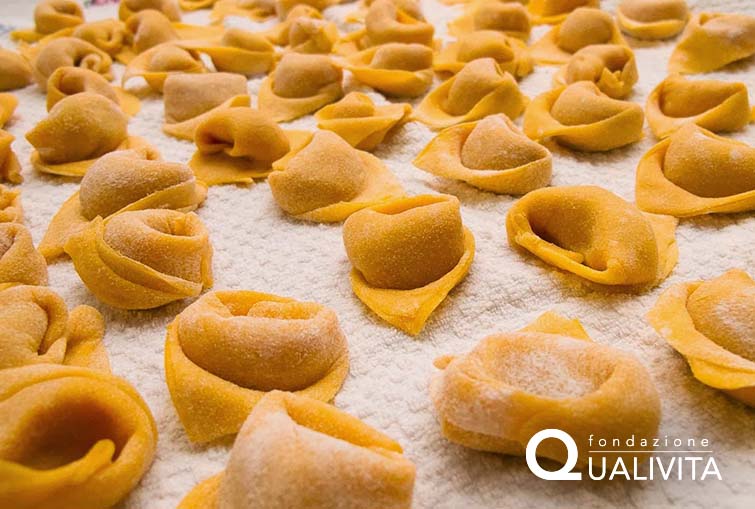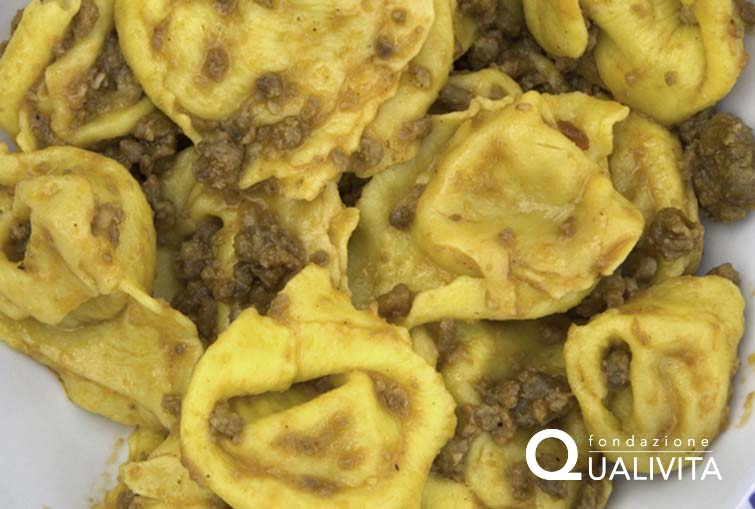Description
Cappellacci di Zucca Ferraresi PGI are fresh stuffed pasta, the pasta of which is made from a mixture of 00 soft wheat flour, durum wheat flour and eggs, with a filling of Cucurbita Moschata squash, commonly known as the violin squash, grated cheese, breadcrumbs and nutmeg.
Production Area
The production area of Cappellacci di Zucca Ferraresi PGI is within the entire territory of the Province of Ferrara, in the Emilia Romagna region.
Production Method
The pasta for Cappellacci di Zucca Ferraresi PGI is made by mixing 00 soft wheat flour, durum wheat flour and eggs. The dough is then rolled out by hand with a wooden rolling pin, or with the aid of a roller machine, to obtain sheets of pasta with a thickness of between 0.4 e 0.7 mm. The filling is made by cutting open and deseeding the squashes, then cooking them in the oven for 120-140 minutes; they are then left to cool. The pulp is removed and the grated cheese, breadcrumbs, nutmeg and any sugar are added. Frozen squashes may also be used. The sheet of pasta is then cut into squares with sides of either 6.5 or 9.5 cm, inside which the filling is placed. The pasta is then folded into a triangle and the two ends are joined at an acute angle to prevent the filling leaking out and give the pasta its typical hat shape.
Appearance and Flavour
Cappellacci di Zucca Ferraresi PGI are round and folded. They have a diameter ranging from 4 to 7 cm and weigh between 10 to 28 g. They are the typical yellow of egg pasta, with darker hues around the filling because of the dark yellow-colour of the ripe squash. The consistency of the dough must be medium to soft. The overall flavour is that of fresh pasta, with a clear contrast between the sweet squash, salty cheese and nutmeg aroma.
History
According to historians, the origins of Cappellacci di Zucca Ferraresi PGI date back to the Renaissance, as evidenced by the cookbook Dello Scalco written by Giovan Battista Rossetti in 1584. As well as the use of squash, a typical crop in the countryside around Ferrara, Cappellacci di Zucca Ferraresi are also made with an egg pasta-making process that has been used for centuries in the production area, as described in the cookbook Banchetti composizione di vivande e apparecchio generale, written by Cristoforo da Messisbugo in 1549. Despite its “poor man’s” squash filling, this product was considered luxury and prestigious, worthy enough to be served on official occasions. Today’s product name can be found as far back as the 19th century, in classic cookbooks on Ferrarese cuisine.
Gastronomy
Cappellacci di Zucca Ferraresi PGI are very tasty with a meat sauce, but to fully appreciate the flavour of the squash they should be simply dressed with melted butter, sage and a sprinkling of Parmigiano Reggiano PDO or Grana Padano PDO. Cappellacci di Zucca Ferraresi PGI pair well with a mature, dry white wine with a delicate aroma and sapid flavour, to contrast the sweetness of the squash, for example Romagna Albana PDO or white Bosco Eliceo PDO.
Marketing
The product is marketed as Cappellacci di Zucca Ferraresi PGI and is available both packed and loose. The product can be sold in packets weighing no less than 100 g and up to 2 kg.
Distinctive Features
The unusual squash filling is most definitely what makes Cappellacci di Zucca Ferraresi PGI unique and unmistakable, as well as their shape, which is reminiscent of the straw hat once worn by Ferrarese farmers, known as a caplaz in the local dialect.












